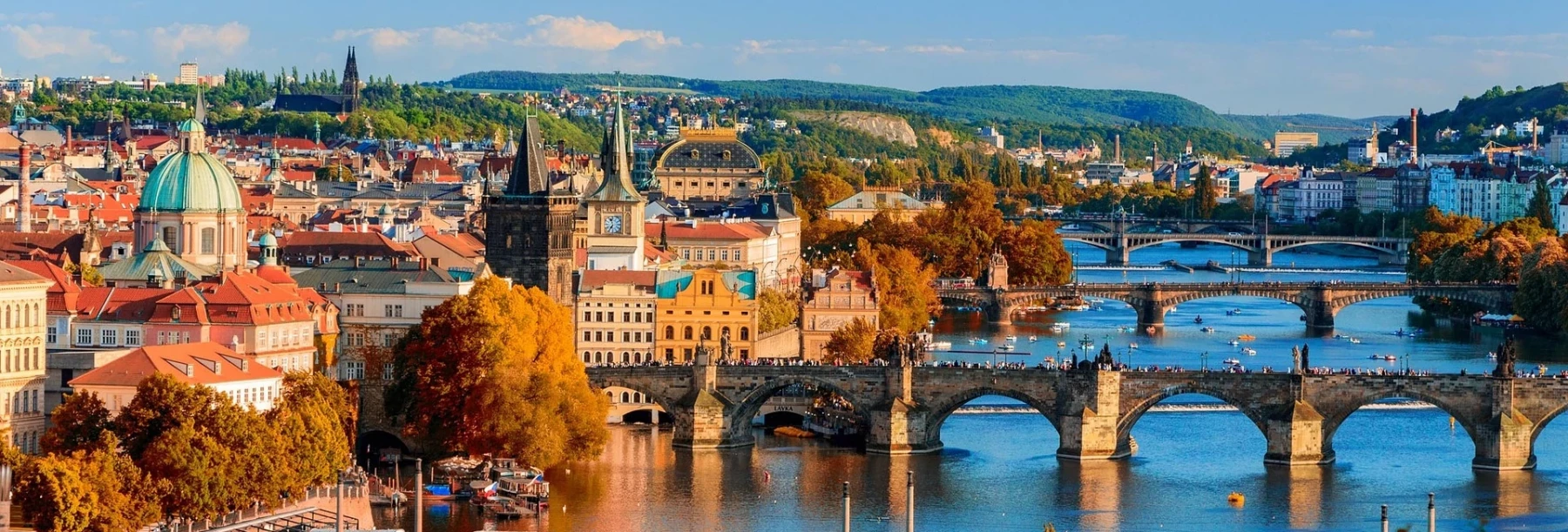Les 14 activités indispensables à expérimenter lors de votre séjour à Prague
Dernière mise à jour : 26/05/2024 15:41Sommaire
- A visiter
-
- 1 - Visitez le Château de Prague (Pražský hrad)
- 2 - Pont Charles (Karlův most)
- 3 - Promenez-vous dans la Vieille Ville (Staré Město)
- 4 - Visitez le quartier juif (Josefov)
- 5 - L’horloge astronomique de Prague
- 6 - Montagne de Petřín (Petřínská rozhledna)
- 7 - Faites une croisière sur la Vltava
- 8 - Le Palais Lobkowicz
- 9 - Découvrez le quartier de Malá Strana
- 10 - Les jardins Wallenstein
- 11 - Musée national (Národní muzeum)
- 12 - Excursion à Český Krumlov
- 13 - Dégustez la cuisine tchèque
- 14 - Profitez de la vie nocturne
- Prague - Où Loger ?
- Prague - Comment se déplacer ?
- Prague - Meilleure période
Prague, surnommée la "ville aux cent clochers" ou la "ville dorée", est une destination enchanteresse qui capture l'imagination de ses visiteurs avec son riche héritage historique, son architecture époustouflante et son atmosphère romantique. Située au cœur de l'Europe centrale, la capitale de la République tchèque est un véritable joyau architectural et culturel qui offre une expérience de voyage inoubliable.
Prague est également réputée pour sa riche scène artistique et culturelle. Les amateurs d'art peuvent se perdre dans les galeries du quartier de Malá Strana, tandis que les mélomanes peuvent assister à un concert de musique classique dans l'une des nombreuses églises baroques de la ville.
En vous promenant dans les quartiers animés de Prague, vous découvrirez une cuisine délicieuse et une vie nocturne vibrante. Ne manquez pas de goûter aux spécialités locales telles que le goulash, le trdelník (une pâtisserie sucrée en forme de rouleau) et bien sûr la bière tchèque renommée dans l'un des nombreux pubs traditionnels de la ville.
Que vous soyez un amateur d'histoire, un passionné d'art, un gourmet ou simplement un voyageur en quête de beauté et de charme, Prague ne manquera pas de vous captiver avec son mélange envoûtant de passé glorieux et de modernité dynamique. Une visite à Prague est vraiment une expérience à ne pas manquer pour tout voyageur avide de découvertes et d'aventures.
1 - Visitez le Château de Prague (Pražský hrad)
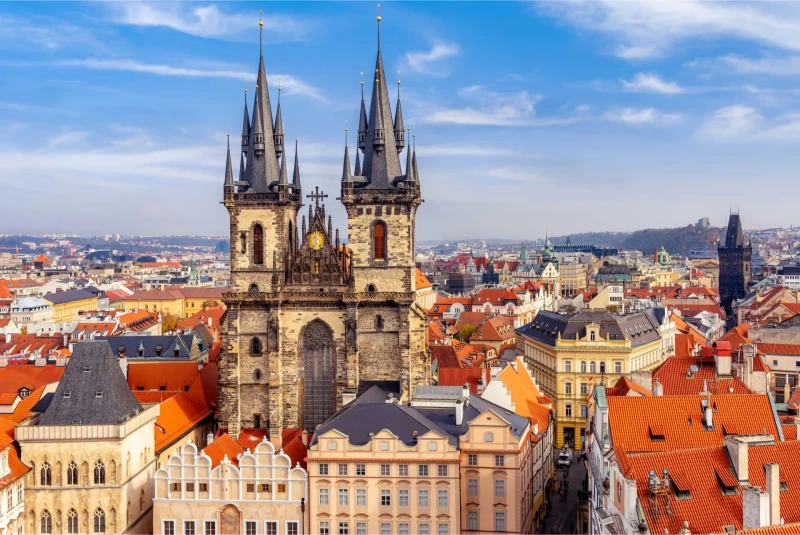
Le Château de Prague, également connu sous le nom de Pražský hrad en tchèque, est l'un des monuments les plus emblématiques de la ville de Prague, en République tchèque. Il est situé sur une colline surplombant la Vltava et domine le panorama de la ville.
Le château a une longue histoire, remontant au IXe siècle, et il a été le siège des rois de Bohême, des empereurs du Saint-Empire romain germanique, des présidents de la Tchécoslovaquie et maintenant de la République tchèque. Il est composé de plusieurs bâtiments historiques, notamment la cathédrale Saint-Guy, le Palais Royal, la Basilique Saint-Georges et la Tour Poudrière.
Aujourd'hui, le Château de Prague est l'une des attractions touristiques les plus visitées de la ville, attirant des millions de visiteurs chaque année pour son architecture magnifique, ses vues panoramiques et son riche patrimoine historique.
 Nos astuces pour tirer le meilleur parti de votre expérience.
Nos astuces pour tirer le meilleur parti de votre expérience.
Visiter le Château de Prague peut être une expérience enrichissante, mais voici quelques astuces pour rendre votre visite plus agréable et sans stress :
-
Planifiez à l'avance : Le château est vaste et il y a beaucoup à voir, alors planifiez votre visite à l'avance en décidant quels bâtiments vous voulez explorer. Considérez également les horaires d'ouverture et les périodes de forte affluence.
-
Arrivez tôt : Pour éviter les foules, essayez de visiter le château tôt le matin ou en fin d'après-midi. Cela vous permettra également de profiter de la vue sur Prague avec moins de monde autour de vous.
-
Achetez vos billets à l'avance : Vous pouvez acheter des billets en ligne à l'avance pour éviter les files d'attente à la billetterie sur place. Cela vous fera gagner du temps et vous permettra d'entrer plus rapidement dans le château.
-
Portez des chaussures confortables : Le château est construit sur une colline, ce qui signifie qu'il y a beaucoup de marches et de pentes à gravir. Assurez-vous de porter des chaussures confortables pour marcher et explorer les environs sans problème.
-
Respectez le code vestimentaire : Si vous prévoyez de visiter la cathédrale Saint-Guy ou d'autres lieux de culte à l'intérieur du château, assurez-vous de respecter le code vestimentaire approprié en évitant les vêtements trop courts ou révélateurs.
-
Prévoyez du temps pour explorer : Le château est immense et abrite de nombreux sites historiques intéressants. Prévoyez suffisamment de temps pour explorer chaque bâtiment et profiter pleinement de votre visite.
-
Renseignez-vous sur l'histoire : Avant votre visite, familiarisez-vous avec l'histoire du château et des principaux sites à voir. Cela vous permettra d'apprécier davantage ce que vous voyez pendant votre visite.
-
Profitez des vues panoramiques : Le château offre certaines des meilleures vues sur la ville de Prague. Prenez le temps d'admirer les panoramas spectaculaires depuis les points de vue à l'intérieur du château.
En suivant ces astuces, vous pourrez profiter pleinement de votre visite au Château de Prague et en faire une expérience mémorable.
2 - Pont Charles (Karlův most)
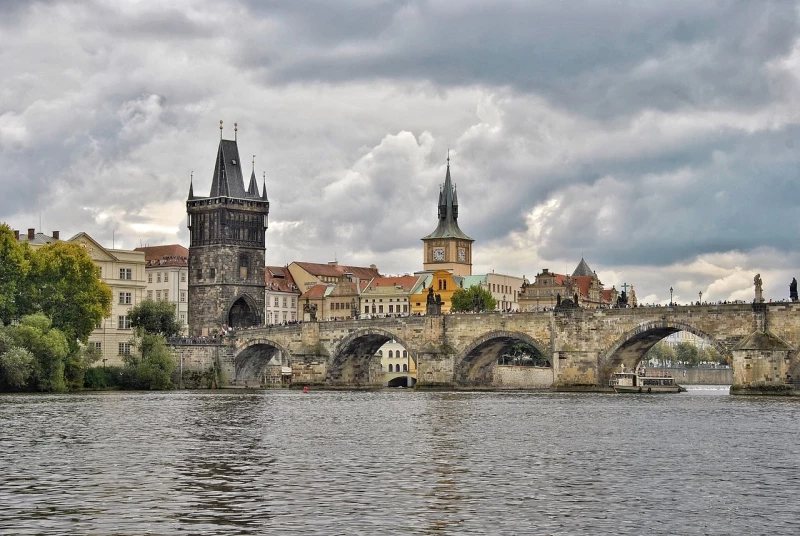
Le Pont Charles, ou Karlův most en tchèque, est un pont historique qui traverse la rivière Vltava à Prague, en République tchèque. Il relie la Vieille Ville (Staré Město) à la Petite Ville (Malá Strana) et au Château de Prague.
Le pont a été commandé par le roi Charles IV au XIVe siècle et a été achevé au début du XVe siècle. C'est l'un des monuments les plus emblématiques de Prague, connu pour ses statues baroques, en particulier celles des saints, qui bordent ses côtés. Le pont est réservé aux piétons, ce qui en fait un lieu très fréquenté par les touristes et les habitants qui viennent profiter des vues sur la ville et ses environs.
Le Pont Charles revêt une importance culturelle et historique significative à Prague et est souvent animé d'activités, notamment des artistes de rue, des musiciens et des vendeurs. Il a été représenté dans de nombreuses œuvres d'art et sert de symbole à la riche histoire et au patrimoine architectural de Prague.
 Nos astuces pour tirer le meilleur parti de votre expérience.
Nos astuces pour tirer le meilleur parti de votre expérience.
Voici quelques astuces pour visiter le Pont Charles (Karlův most) à Prague :
-
Évitez les foules : Le pont est souvent très fréquenté par les touristes, en particulier pendant la journée. Pour éviter les foules, essayez de visiter le pont tôt le matin ou en fin de soirée.
-
Profitez des vues : Le Pont Charles offre des vues magnifiques sur Prague, en particulier au lever et au coucher du soleil. Assurez-vous d'apporter votre appareil photo pour capturer ces moments mémorables.
-
Appréciez les statues : Prenez le temps d'admirer les statues baroques qui ornent le pont. Chacune a une histoire unique et représente un saint ou une figure importante de l'histoire tchèque.
-
Explorez les environs : Le Pont Charles se trouve dans un quartier historique de Prague. Profitez-en pour explorer la Vieille Ville, la Petite Ville et le Château de Prague, qui se trouvent à proximité.
-
Interagissez avec les artistes de rue : Le pont est souvent animé par des artistes de rue, des musiciens et des vendeurs. Prenez le temps d'apprécier leur talent et peut-être même d'acheter une œuvre d'art locale en souvenir.
-
Appréciez l'architecture : Outre les statues, le pont lui-même est un exemple remarquable d'architecture médiévale. Admirez les arches gothiques et les détails sculptés qui ornent la structure.
-
Soyez conscient de la sécurité : Comme dans tout lieu touristique animé, gardez un œil sur vos effets personnels pour éviter les vols à la tire. De plus, soyez prudent lorsque vous traversez la rue, car le pont est souvent fréquenté par des piétons.
En suivant ces conseils, vous pourrez profiter pleinement de votre visite au Pont Charles et en faire une expérience mémorable à Prague.
3 - Promenez-vous dans la Vieille Ville (Staré Město)
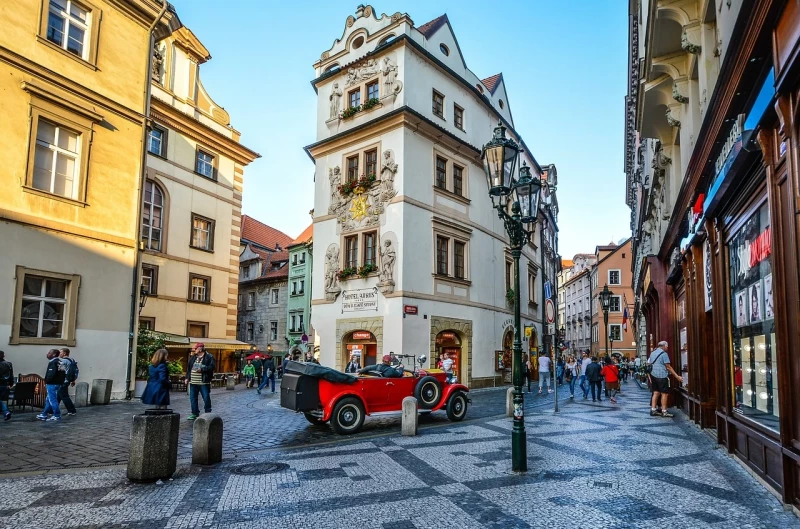
La Vieille Ville, également connue sous le nom de Staré Město, est le centre historique de Prague, la capitale de la République tchèque. C'est l'un des centres médiévaux les plus importants et les mieux préservés d'Europe et il a été inscrit sur la liste du patrimoine mondial de l'UNESCO depuis 1992.
La Vieille Ville est renommée pour son architecture époustouflante, notamment l'emblématique Horloge astronomique de Prague, l'église gothique de Notre-Dame avant Týn et la magnifique place de la Vieille Ville. La région abrite également de nombreuses rues étroites pavées, des cafés charmants, des marchés animés et des sites historiques.
Les visiteurs de la Vieille Ville peuvent explorer son riche passé en se promenant dans ses rues sinueuses, en visitant des musées tels que le Musée juif de Prague ou en prenant des visites guidées de ses sites les plus célèbres. La région est une destination prisée des touristes et des habitants, offrant un mélange unique d'histoire, de culture et de charme.
 Nos astuces pour tirer le meilleur parti de votre expérience.
Nos astuces pour tirer le meilleur parti de votre expérience.
Voici quelques astuces pour profiter au maximum de votre promenade dans la Vieille Ville de Prague (Staré Město) :
-
Horaires de visite : Essayez de visiter la Vieille Ville tôt le matin ou en fin de journée pour éviter les foules de touristes. Cela vous permettra également de profiter de la beauté de la ville dans une atmosphère plus calme.
-
Carte et orientation : Obtenez une carte de la Vieille Ville et repérez les principaux sites que vous souhaitez visiter. Les rues de la Vieille Ville peuvent être un peu déroutantes, donc avoir une carte peut vous aider à vous orienter.
-
Promenez-vous sans but : Perdez-vous dans les ruelles pittoresques de la Vieille Ville. C'est souvent dans ces petites rues que vous découvrirez les véritables joyaux cachés de la ville.
-
Visitez les attractions principales : Ne manquez pas les sites emblématiques tels que l'Horloge astronomique, l'église de Notre-Dame avant Týn et la place de la Vieille Ville. Assurez-vous également de visiter le Pont Charles, qui relie la Vieille Ville au quartier de Malá Strana.
-
Explorez les petites places : En plus de la place de la Vieille Ville, explorez les petites places et les cours cachées de la région. Vous y trouverez souvent des cafés pittoresques et des boutiques artisanales.
-
Dégustez la cuisine locale : Profitez de votre promenade pour goûter à la délicieuse cuisine tchèque. Arrêtez-vous dans un restaurant local pour déguster des plats traditionnels tels que le goulasch, les knedlíky (quenelles) et les trdelník (pâtisseries enroulées autour d'un cylindre).
-
Visitez les musées et galeries : La Vieille Ville abrite de nombreux musées et galeries d'art intéressants. Prenez le temps de visiter ceux qui vous intéressent pour en apprendre davantage sur l'histoire et la culture de Prague.
En suivant ces astuces, vous êtes sûr de passer un moment agréable et mémorable à explorer la magnifique Vieille Ville de Prague.
4 - Visitez le quartier juif (Josefov)
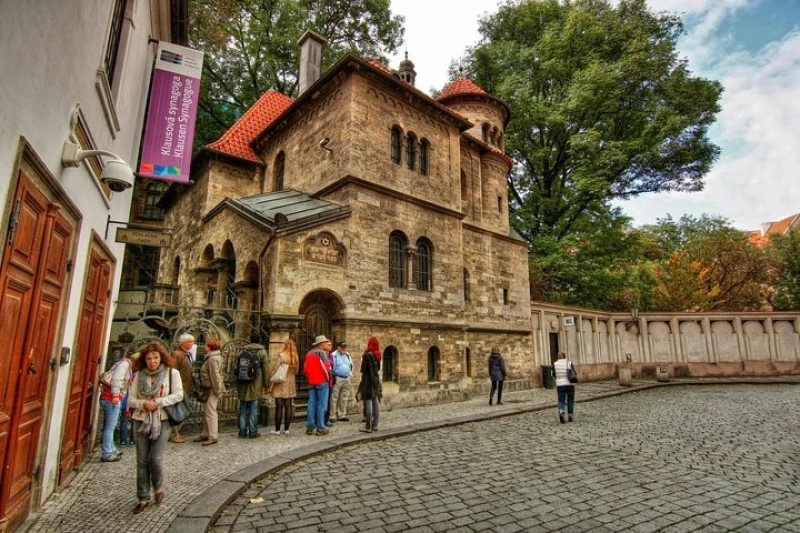
Le quartier juif de Prague, également connu sous le nom de Josefov, est l'un des quartiers les plus historiquement riches et culturellement importants de la ville. Situé dans la Vieille Ville de Prague, il a une histoire qui remonte à plus de 1000 ans. Voici quelques faits saillants sur le quartier juif :
-
Histoire antique : Les premières traces de présence juive dans la région remontent au 10ème siècle. Au fil des siècles, la communauté juive a prospéré, bien que périodiquement soumise à la discrimination et aux persécutions.
-
Restrictions et ghetto : Au Moyen Âge, les Juifs de Prague étaient soumis à diverses restrictions, et au 16ème siècle, l'empereur Ferdinand Ier les a contraints à vivre dans un ghetto clos. Le ghetto a été préservé, ce qui en fait l'un des seuls quartiers juifs médiévaux bien conservés en Europe.
-
Synagogues : Le quartier abrite plusieurs synagogues historiques, dont certaines sont toujours en activité. La plus ancienne est la Vieille-Nouvelle Synagogue, qui date du 13ème siècle. La synagogue espagnole et la synagogue Maisel font également partie des principaux sites à visiter.
-
Cimetière juif : Le cimetière juif de Prague, l'un des plus anciens d'Europe, est un site impressionnant avec des milliers de pierres tombales, dont certaines datent du 15ème siècle. En raison de l'espace limité dans le ghetto, les tombes ont été entassées les unes sur les autres, créant une atmosphère unique et poignante.
-
Musée juif : Le quartier abrite également un musée juif qui raconte l'histoire et la culture juives à Prague. Il comprend plusieurs bâtiments historiques, notamment l'ancien hôtel de ville juif et la synagogue Pinkas, qui sert de mémorial aux victimes de l'Holocauste.
-
Héritage culturel : Le quartier juif de Prague est non seulement un lieu d'importance historique, mais aussi un centre culturel dynamique avec des festivals, des événements artistiques et des activités communautaires tout au long de l'année.
Le quartier juif de Prague est donc un incontournable pour les visiteurs intéressés par l'histoire juive européenne et l'architecture médiévale, ainsi que pour ceux qui cherchent à comprendre l'histoire complexe et parfois sombre de la ville de Prague.
5 - L’horloge astronomique de Prague
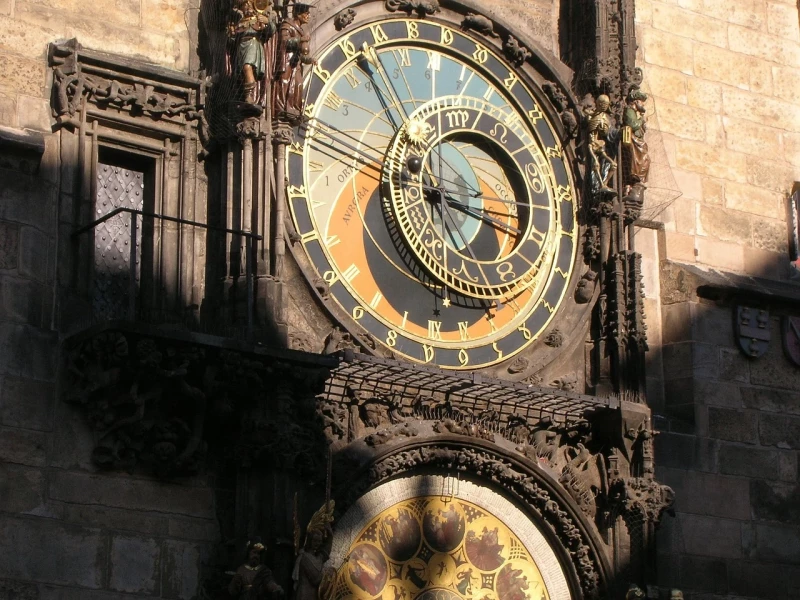
L'horloge astronomique de Prague, également connue sous le nom de l'horloge astronomique de la Vieille Ville, est l'une des attractions les plus célèbres de Prague, en République tchèque. Elle est située sur la tour de l'hôtel de ville de la Vieille Ville et est l'une des horloges astronomiques les plus anciennes et les plus complexes encore en fonctionnement.
L'horloge a été construite au début du XVe siècle par l'horloger Mikuláš de Kadaň et l'astronome Jan Šindel. Elle mesure plusieurs aspects du temps astronomique, comme les positions du soleil et de la lune dans le ciel, les phases lunaires et les mouvements des étoiles. Elle comprend également des représentations artistiques et symboliques liées à la vie médiévale et religieuse.
Chaque heure, entre 9h00 et 21h00, les figurines animées des Douze Apôtres apparaissent dans les fenêtres supérieures de l'horloge, tandis que des statues représentant la Mort, l'Avidité, la Vanité et d'autres vices se mettent en mouvement.
L'horloge astronomique de Prague est non seulement une merveille technique, mais aussi un symbole de l'histoire et de la culture de la ville. Elle attire chaque année des milliers de visiteurs venus admirer sa beauté et son ingéniosité.
6 - Montagne de Petřín (Petřínská rozhledna)
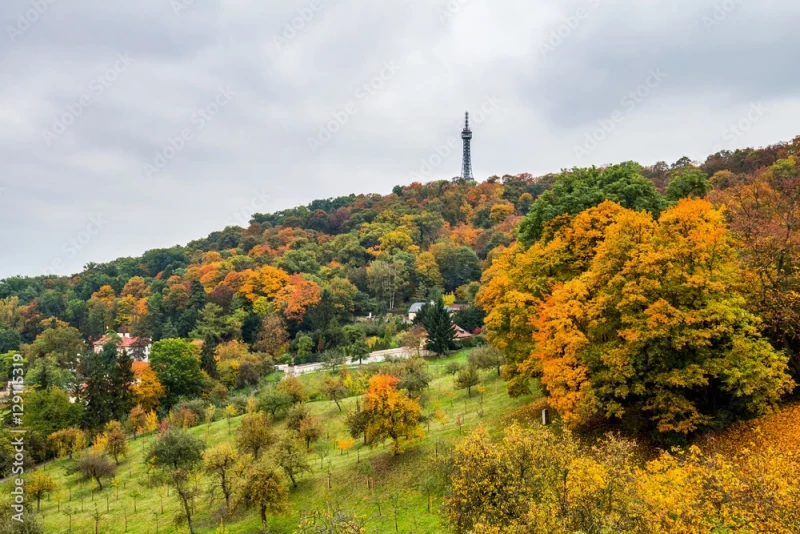
La montagne de Petřín, située à Prague, en République tchèque, est une destination charmante offrant des vues magnifiques sur la ville. Au sommet se dresse la tour de Petřín (Petřínská rozhledna), une structure impressionnante ressemblant à la Tour Eiffel, bien que sur une échelle plus petite. Construite en 1891 pour l'Exposition jubilaire, la tour est une attraction touristique populaire et un point d'observation.
Les visiteurs peuvent monter à la tour via un escalier en colimaçon ou un ascenseur. Du sommet, vous bénéficiez de vues panoramiques sur le paysage pittoresque de Prague, y compris son architecture historique, la rivière Vltava qui serpente et les toits charmants de la ville. C'est un endroit parfait pour les amateurs de photographie, les couples en quête d'une vue romantique, ou simplement pour quiconque souhaite admirer la beauté de Prague d'en haut. De plus, la montée de la colline pour atteindre la tour est une expérience agréable en elle-même, avec une végétation luxuriante et des sentiers sinueux qui ajoutent à l'expérience.
 Nos astuces pour tirer le meilleur parti de votre expérience.
Nos astuces pour tirer le meilleur parti de votre expérience.
Si vous prévoyez de visiter la Montagne de Petřín et la tour Petřínská rozhledna à Prague, voici quelques astuces pour rendre votre expérience plus agréable :
-
Choisissez le bon moment de la journée : Le lever du soleil ou le coucher du soleil offrent des vues spectaculaires depuis la tour. Évitez les heures de pointe touristiques pour une expérience plus paisible.
-
Préparez-vous à la montée : Si vous choisissez de monter à la tour à pied, portez des chaussures confortables. La montée peut être un peu raide, mais elle vaut la peine pour la vue panoramique.
-
Utilisez l'ascenseur si nécessaire : Si la montée à pied semble trop difficile, la tour dispose également d'un ascenseur pour vous transporter rapidement au sommet.
-
Profitez des jardins de Petřín : Avant d'atteindre la tour, explorez les jardins de Petřín qui entourent la montagne. C'est un endroit paisible pour se détendre et admirer la nature.
-
Apportez une caméra : La vue depuis le sommet de la tour est incroyable, alors assurez-vous d'apporter un appareil photo pour capturer des souvenirs mémorables de Prague.
-
Vérifiez les horaires d'ouverture : Assurez-vous de vérifier les horaires d'ouverture de la tour avant votre visite pour éviter toute déception en cas de fermeture exceptionnelle.
-
Consultez les conditions météorologiques : La visibilité peut varier en fonction des conditions météorologiques. Choisissez une journée claire pour une vue optimale.
-
Explorez les environs : Une fois descendu de la tour, explorez les alentours de la montagne de Petřín, y compris le parc et d'autres attractions à proximité.
En suivant ces conseils, vous pourrez tirer le meilleur parti de votre visite à la Montagne de Petřín et à la tour Petřínská rozhledna, et profiter pleinement de la beauté de Prague depuis cette perspective unique.
7 - Faites une croisière sur la Vltava
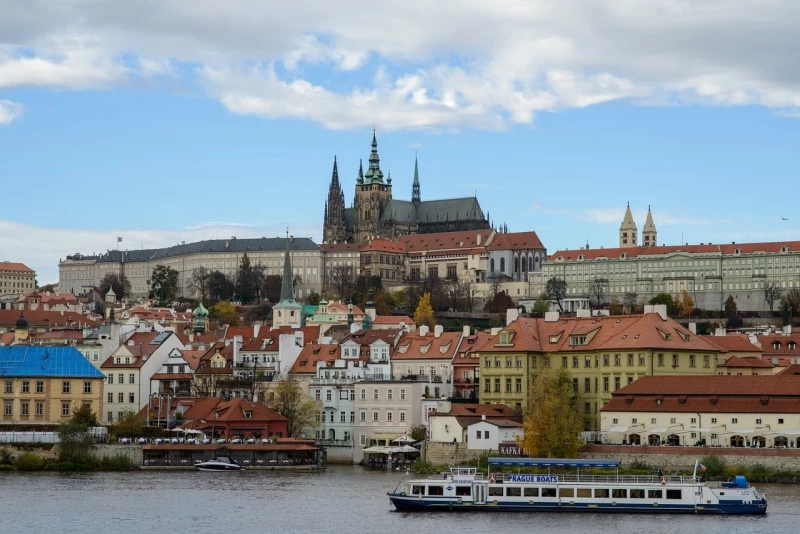
Une croisière sur la Vltava, ça semble être une expérience magnifique ! La Vltava est le plus grand fleuve de la République tchèque et traverse Prague, offrant ainsi une vue imprenable sur certains des sites les plus emblématiques de la ville, comme le château de Prague, le pont Charles et la vieille ville. Naviguer sur ses eaux tranquilles tout en admirant l'architecture époustouflante et les paysages pittoresques doit être vraiment enchanteur. Vous pouvez également profiter de croisières de nuit pour voir Prague illuminée, créant une atmosphère vraiment magique.
 Nos astuces pour tirer le meilleur parti de votre expérience.
Nos astuces pour tirer le meilleur parti de votre expérience.
Voici quelques points clés à considérer pour une croisière sur la Vltava à Prague :
-
Point de Départ : Les croisières sur la Vltava commencent généralement au cœur de Prague. Vous pouvez embarquer à différents endroits le long du fleuve, mais certains départs populaires incluent près du pont Charles ou du quai de Rašín.
-
Durée de la Croisière : Les croisières varient en durée, certaines étant courtes et d'autres plus longues. Une croisière typique dure environ une heure, mais des options plus longues peuvent inclure des repas ou des visites guidées plus approfondies.
-
Points d'Intérêt : En naviguant sur la Vltava, vous passerez devant de nombreux monuments emblématiques de Prague, tels que le château de Prague, le pont Charles, la tour de Petřín et la vieille ville. La perspective depuis le fleuve offre des vues uniques sur ces sites historiques.
-
Croisières Thématisées : Certains opérateurs proposent des croisières thématiques, comme des dîners-croisières romantiques, des croisières au coucher du soleil ou des croisières avec musique en direct. Choisissez celle qui correspond le mieux à vos préférences.
-
Informations Historiques : De nombreuses croisières incluent des commentaires en direct ou enregistrés sur l'histoire et les faits intéressants concernant les monuments que vous rencontrez. Cela peut enrichir votre expérience en vous fournissant des informations contextuelles.
-
Saisonnalité : Les croisières sur la Vltava sont populaires toute l'année, mais la saison estivale offre généralement des conditions météorologiques plus agréables. Certains opérateurs peuvent également proposer des croisières spéciales pendant les festivals ou événements locaux.
-
Réservation : Il est recommandé de réserver votre croisière à l'avance, surtout pendant les périodes touristiques, pour vous assurer d'avoir une place à bord.
Faire une croisière sur la Vltava offre une perspective unique sur l'architecture et l'histoire de Prague, et c'est une excellente façon de se détendre tout en découvrant cette magnifique ville depuis un autre angle.
8 - Le Palais Lobkowicz

Le Palais Lobkowicz est un joyau culturel fascinant situé à Prague, en République tchèque. Il est renommé pour son histoire riche, ses collections artistiques impressionnantes et son architecture époustouflante. Le palais abrite les Collections Lobkowicz, qui comprennent des œuvres d'art de classe mondiale, des objets d'art décoratif, des artefacts historiques et des manuscrits accumulés au fil des siècles par la famille Lobkowicz.
Les visiteurs peuvent explorer les salles somptueuses du palais, qui offrent des éclairages sur la vie de la famille Lobkowicz et les événements historiques auxquels elle a assisté. Parmi les points forts de la collection figurent des œuvres d'artistes célèbres tels que Bruegel, Canaletto et Velázquez, ainsi que des manuscrits originaux de Mozart et Beethoven.
En plus de sa signification culturelle, le palais offre également des vues imprenables sur le château de Prague et le panorama de la ville. C'est une destination incontournable pour quiconque s'intéresse à l'art, à l'histoire et au patrimoine culturel de la République tchèque.
9 - Découvrez le quartier de Malá Strana

Le quartier de Malá Strana, littéralement "le petit côté" en français, est l'un des quartiers les plus charmants et historiques de Prague, situé sur la rive ouest de la Vltava, juste en dessous du château de Prague. Avec ses ruelles pittoresques, ses bâtiments colorés et ses magnifiques églises baroques, Malá Strana dégage une atmosphère médiévale captivante.
Parmi ses points d'intérêt les plus célèbres, on trouve l'église Saint-Nicolas, un superbe exemple d'architecture baroque, ainsi que la place Malostranské náměstí avec sa colonne de la Sainte-Trinité. La rue Nerudova, bordée de maisons anciennes et de boutiques pittoresques, est une autre attraction majeure de ce quartier.
Malá Strana regorge également de restaurants, de cafés et de bars, ce qui en fait un endroit idéal pour se promener et découvrir l'atmosphère unique de Prague. De là, vous pouvez également accéder facilement à d'autres sites touristiques majeurs de la ville, comme le pont Charles et la vieille ville.
10 - Les jardins Wallenstein
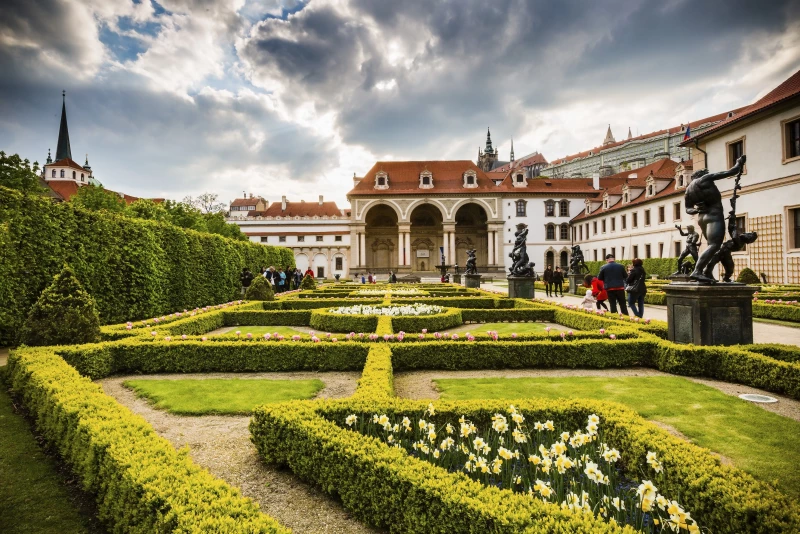
Les Jardins Wallenstein, connus sous le nom tchèque "Valdštejnská zahrada", sont des jardins baroques situés à Prague, en République tchèque. Ils font partie du complexe du Palais Wallenstein, qui abrite actuellement le Sénat tchèque. Ces jardins sont ouverts au public et offrent un refuge paisible au cœur de la ville.
Les Jardins Wallenstein sont conçus dans un style baroque italien et ont été créés au début du XVIIe siècle. Ils sont agrémentés de fontaines, de statues, de terrasses, et de parterres de fleurs soigneusement entretenus. L'un des points forts du jardin est la grande fontaine avec une statue de Neptune, entourée de figures mythologiques.
En plus de l'aspect esthétique, les Jardins Wallenstein offrent une vue panoramique sur le quartier de Malá Strana et le château de Prague. Ils constituent un endroit agréable pour se promener, se détendre et apprécier la beauté paisible de la nature au cœur de la ville historique.
11 - Musée national (Národní muzeum)
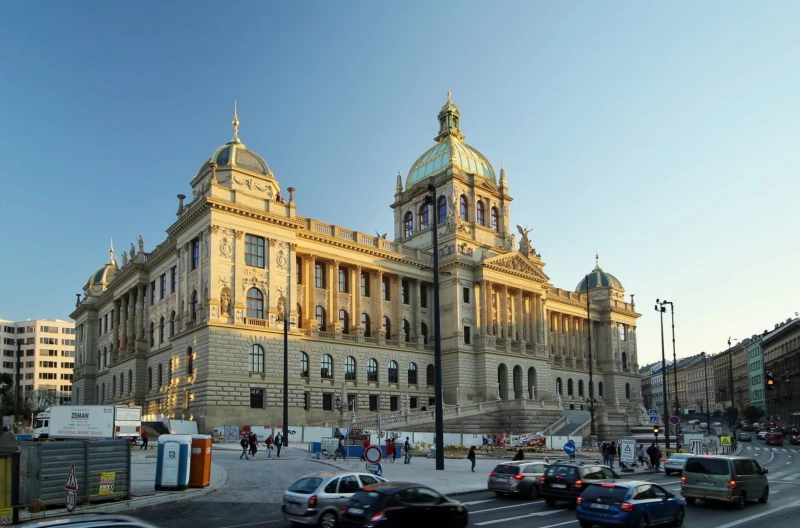
Le Musée national (Národní muzeum) est une institution culturelle de premier plan située à Prague, en République tchèque. Il s'agit de l'un des plus grands musées du pays, couvrant un large éventail de disciplines, dont l'histoire naturelle, l'histoire, les arts et la musique.
Le musée a été fondé en 1818 et est depuis devenu un symbole de l'identité nationale et du patrimoine tchèques. Son bâtiment principal, situé sur la place Venceslas, est en soi un chef-d'œuvre architectural, présentant un design néo-renaissance conçu par l'architecte Josef Schulz. Le bâtiment a fait l'objet de rénovations importantes et a rouvert ses portes au public en 2018, mettant en valeur à la fois son importance historique et ses installations modernes.
Au sein du musée, les visiteurs peuvent explorer une vaste gamme d'expositions, comprenant des collections géologiques et paléontologiques, des artefacts archéologiques, des documents historiques, des œuvres d'art et des instruments de musique. Parmi les points forts, citons la Vénus de Dolní Věstonice, une sculpture en céramique vieille de 29 000 ans, et l'Épopée slave, une série de peintures monumentales d'Alfons Mucha représentant l'histoire et la mythologie slaves.
Le Musée national est un centre d'éducation, de recherche et d'enrichissement culturel, offrant aux visiteurs une compréhension approfondie de l'histoire, de la culture et du patrimoine naturel tchèques. C'est une destination incontournable pour quiconque souhaite explorer la riche diversité de la civilisation tchèque.
12 - Excursion à Český Krumlov
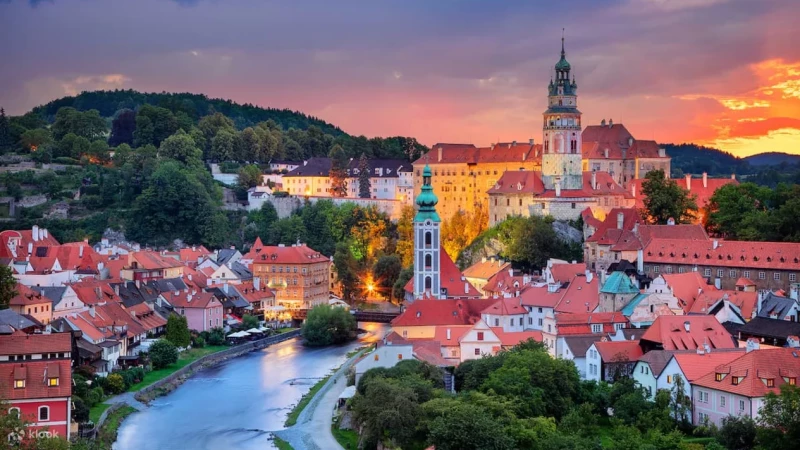
Une excursion à Český Krumlov depuis Prague est une excellente idée pour découvrir la beauté de cette ville médiévale. Voici quelques étapes que vous pourriez suivre pour organiser cette excursion :
-
Transport : La distance entre Prague et Český Krumlov est d'environ 170 kilomètres, ce qui fait de la voiture, du train ou du bus des options viables. Si vous préférez une option plus confortable, des agences de voyages proposent souvent des excursions d'une journée avec un transport aller-retour depuis Prague.
-
Horaires : Český Krumlov est une petite ville, mais il y a beaucoup à voir. Idéalement, partez de Prague le matin pour maximiser le temps passé à explorer. Vérifiez les horaires de transport pour vous assurer d'avoir suffisamment de temps sur place.
-
Château de Český Krumlov : Commencez votre visite par le château de Český Krumlov, qui est le point central de la ville. Explorez les cours, les jardins et les intérieurs richement décorés. La vue depuis le château offre également une perspective magnifique sur la ville.
-
Vieux centre-ville : Descendez ensuite vers le vieux centre-ville médiéval. Flânez dans les rues pavées, admirez les maisons colorées, et découvrez la place principale avec ses cafés et ses boutiques.
-
La rivière Vltava : Profitez d'une balade le long des rives de la Vltava. Vous pouvez également envisager une courte croisière en bateau pour une vue différente de la ville.
-
Musées et galeries : Si le temps le permet, visitez quelques-uns des petits musées et galeries d'art disséminés dans la ville. Ils offrent souvent un aperçu intéressant de l'histoire locale et de la culture.
-
Dégustation de la cuisine locale : Terminez votre journée avec une dégustation de la cuisine tchèque dans l'un des restaurants locaux. Essayez des plats traditionnels pour une expérience complète.
Assurez-vous de vérifier les horaires de transport pour le retour à Prague et planifiez en conséquence. Český Krumlov offre une expérience unique avec son atmosphère médiévale préservée, faisant de cette excursion une escapade mémorable depuis la capitale tchèque.
 Nos astuces pour tirer le meilleur parti de votre expérience.
Nos astuces pour tirer le meilleur parti de votre expérience.
Faire une excursion à Český Krumlov depuis Prague est une excellente idée, et voici quelques astuces pour rendre votre voyage aussi agréable que possible :
-
Planification préalable : Vérifiez les horaires des trains, bus ou visites organisées pour planifier votre journée de manière efficace. Les horaires peuvent varier, alors assurez-vous d'avoir suffisamment de temps pour explorer la ville.
-
Réservez à l'avance : Si vous optez pour une visite organisée, il peut être judicieux de réserver à l'avance, surtout pendant la haute saison touristique, pour garantir votre place.
-
Départ matinal : Pour maximiser votre temps à Český Krumlov, partez de Prague tôt le matin. Cela vous donne plus de temps pour visiter les sites principaux sans vous précipiter.
-
Visite guidée : Considérez une visite guidée. Un guide peut fournir des informations historiques et culturelles enrichissantes, vous aidant à mieux comprendre l'histoire de Český Krumlov.
-
Profitez du château tôt le matin : Comme le château de Český Krumlov est l'une des principales attractions, essayez de le visiter tôt le matin pour éviter les foules.
-
Explorez la vieille ville à pied : La vieille ville est pleine de charme avec ses rues pavées et ses bâtiments colorés. Explorez-la à pied pour découvrir tous les coins pittoresques.
-
Croisière sur la Vltava : Si le temps le permet, envisagez une courte croisière sur la rivière Vltava. C'est une excellente façon de voir la ville depuis un autre point de vue.
-
Dégustez la cuisine locale : Essayez la cuisine tchèque dans l'un des restaurants locaux. Český Krumlov offre une variété de plats traditionnels.
-
Prévoyez du temps libre : Bien que la planification soit importante, assurez-vous de laisser un peu de temps libre pour vous perdre dans les rues, découvrir des endroits inattendus et vous immerger dans l'ambiance de la ville.
-
Vérifiez les horaires de retour : Assurez-vous de connaître les horaires des trains ou bus de retour à Prague et planifiez votre temps en conséquence pour ne pas manquer votre moyen de transport.
En suivant ces astuces, vous maximiserez votre expérience lors de cette excursion à Český Krumlov depuis Prague. Profitez de la beauté médiévale de cette charmante ville tchèque !
13 - Dégustez la cuisine tchèque
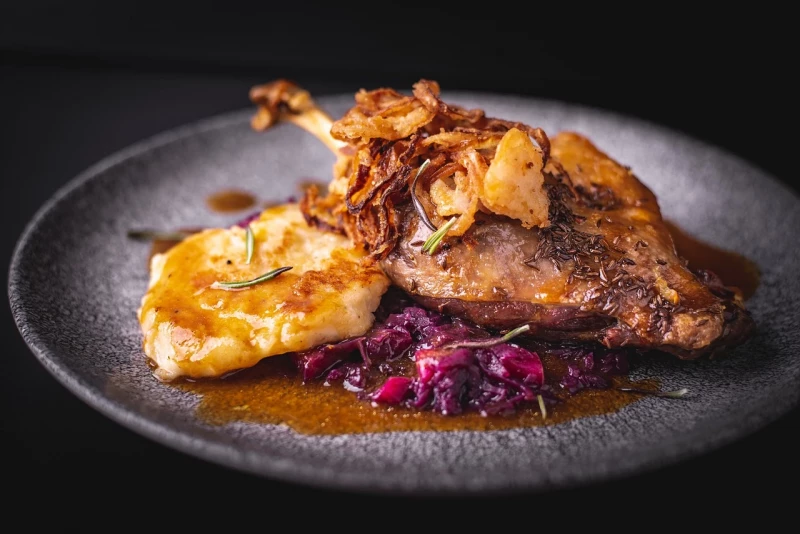
La cuisine tchèque est riche, savoureuse et reflète l'histoire et la culture du pays. Voici quelques plats et spécialités culinaires tchèques que vous pourriez apprécier :
-
Svíčková na smetaně : C'est l'un des plats tchèques les plus emblématiques. Il s'agit d'un rôti de viande (généralement du bœuf) servi avec une sauce à la crème, des cranberries et une crêpe de pain de seigle.
-
Goulash : Le goulash tchèque est une version savoureuse du ragoût de viande, généralement préparé avec du bœuf, des oignons, des poivrons et des épices. Il est souvent accompagné de knedlíky, des boules de pâte ou de pommes de terre.
-
Trdelník : Une pâtisserie populaire en République tchèque, le trdelník est une pâte sucrée enroulée autour d'un cylindre, grillée et souvent saupoudrée de sucre, de noix ou de cannelle.
-
Smažený sýr : Il s'agit de fromage pané et frit, souvent accompagné de frites et de salade. C'est une option populaire pour les amateurs de fromage.
-
Koláče : Ces petits gâteaux sucrés sont souvent garnis de confiture, de fruits, de noix ou de graines de pavot. Ils sont parfaits pour accompagner une tasse de café.
-
Pilsner : La République tchèque est réputée pour sa bière, et la Pilsner est une des marques les plus célèbres. Les Tchèques ont une longue tradition brassicole, et déguster une bière locale est une expérience incontournable.
-
Knedlíky : Ces boules de pâte, similaires à des quenelles, sont souvent servies en accompagnement de plats principaux. Elles peuvent être faites de pommes de terre ou de farine, et sont excellentes pour absorber les sauces.
-
Vepřo-knedlo-zelo : Un plat classique tchèque composé de rôti de porc (vepřové), knedlíky (boules de pâte) et choucroute (zelí).
-
Utopenec : C'est une saucisse marinée souvent servie en apéritif, parfois avec des oignons, des poivrons et d'autres légumes marinés.
-
Svíčková : Une soupe crémeuse à base de foie, de racine de persil, de céleri, d'oignons et de crème fraîche.
La cuisine tchèque offre une variété de plats délicieux et copieux, reflétant l'héritage culinaire unique du pays. En explorant ces plats, vous aurez une meilleure compréhension de la culture gastronomique tchèque.
 Nos astuces pour tirer le meilleur parti de votre expérience.
Nos astuces pour tirer le meilleur parti de votre expérience.
Déguster la cuisine tchèque peut être une expérience délicieuse et enrichissante. Voici quelques astuces pour profiter au mieux de cette expérience culinaire :
-
Essayez les spécialités locales : Optez pour des plats traditionnels tchèques tels que le svíčková, le goulash, les knedlíky, et les koláče. Ces plats emblématiques offrent un aperçu authentique de la cuisine tchèque.
-
Explorez les marchés locaux : Visitez les marchés locaux pour découvrir des produits frais, des fromages régionaux, des saucisses artisanales et d'autres délices. Cela peut également être l'occasion de déguster des spécialités locales.
-
Accompagnez vos repas d'une bière tchèque : La République tchèque est célèbre pour sa bière de qualité. Essayez différentes marques locales pour accompagner vos repas et découvrez la richesse de la tradition brassicole tchèque.
-
Visitez des restaurants locaux : Évitez les chaînes internationales et privilégiez les restaurants locaux. Ces établissements proposent souvent une cuisine plus authentique et préparée avec des ingrédients locaux.
-
Participez à des festivals culinaires : Si votre visite coïncide avec un festival culinaire local, n'hésitez pas à y participer. Vous aurez l'occasion de goûter à une variété de plats, de boissons et de produits régionaux.
-
Demandez des recommandations : Interagissez avec les habitants ou le personnel des restaurants et demandez-leur des recommandations. Les locaux peuvent vous guider vers des plats moins connus mais tout aussi délicieux.
-
Goûtez aux desserts tchèques : Ne manquez pas les délices sucrés tchèques tels que les trdelník, les koláče et les strudels. Ils sont parfaits pour satisfaire votre dent sucrée.
-
Explorez les vins tchèques : En plus de la bière, la République tchèque produit également des vins. Essayez quelques-uns des vins locaux pour découvrir la scène viticole du pays.
-
Respectez les traditions culinaires : Apprenez les traditions liées aux repas tchèques, comme lever son verre pour trinquer (santé !) et ne pas commencer à manger tant que tout le monde n'est pas servi.
-
Soyez ouvert à l'expérimentation : N'hésitez pas à sortir de votre zone de confort culinaire et à essayer des plats que vous ne connaissez pas. Vous pourriez être agréablement surpris.
En suivant ces conseils, vous pourrez savourer pleinement la cuisine tchèque et découvrir les délices gastronomiques que ce pays a à offrir. Bon appétit !
14 - Profitez de la vie nocturne
La vie nocturne à Prague est réputée pour son dynamisme et sa diversité. Voici un aperçu des aspects de la vie nocturne dans la capitale tchèque :
-
Bars et Pubs : Prague regorge de bars et de pubs, offrant une variété de bières tchèques locales ainsi que des cocktails. Les quartiers de Malá Strana et Vinohrady sont particulièrement populaires pour leurs bars à l'ambiance décontractée.
-
Clubs : La scène clubbing à Prague est animée, avec des clubs adaptés à différents goûts musicaux. Le quartier de Žižkov est connu pour ses clubs branchés, tandis que Karlín propose des endroits tendance.
-
Soirées sur les Toits : Profitez de la vue sur la ville en participant à des soirées sur les toits. Certains bars offrent une vue panoramique sur les monuments emblématiques de Prague.
-
Scènes Artistiques Alternatives : Les quartiers tels que Holešovice abritent des lieux alternatifs, des galeries d'art, des espaces créatifs et des clubs underground, parfaits pour ceux qui recherchent une expérience plus alternative.
-
Croisières sur la Vltava : Les croisières nocturnes sur la rivière Vltava offrent une perspective unique de Prague illuminée. Certains bateaux proposent des dîners-croisières avec musique live.
-
Evénements Culturels en Soirée : Consultez le programme culturel de la ville pour découvrir des concerts, des représentations théâtrales, des festivals, et d'autres événements en soirée.
-
Marchés Nocturnes : Pendant la saison estivale, des marchés nocturnes proposent des stands de nourriture, des concerts et des animations dans divers quartiers de Prague.
-
Casinos : Pour ceux qui recherchent une vie nocturne plus animée, certains casinos sont ouverts jusqu'à tard dans la nuit.
-
Cafés et Chilling : Prague compte de nombreux cafés et endroits chill où vous pouvez vous détendre, discuter avec des amis, ou simplement profiter de l'atmosphère.
-
Spectacles de Cabaret et Bars à Thème : Certains endroits proposent des spectacles de cabaret, des bars à thème, ou des soirées spéciales pour une expérience divertissante.
La vie nocturne à Prague offre quelque chose pour tout le monde, que vous recherchiez une soirée tranquille dans un café, une exploration de la scène musicale locale, ou une nuit animée dans les clubs de la ville. Il est recommandé de découvrir différents quartiers pour une expérience complète. Gardez à l'esprit que les horaires d'ouverture peuvent varier, et la vie nocturne à Prague peut être plus calme en début de semaine par rapport aux week-ends.
 Nos astuces pour tirer le meilleur parti de votre expérience.
Nos astuces pour tirer le meilleur parti de votre expérience.
Profiter de la vie nocturne à Prague peut être une expérience excitante et mémorable. Voici quelques astuces pour en tirer le meilleur parti :
-
Découvrez différents quartiers : Prague offre une variété de quartiers, chacun avec son propre caractère et sa propre scène nocturne. Explorez des endroits comme Malá Strana, Vinohrady, Žižkov et Karlín pour une expérience diversifiée.
-
Faites une tournée des bars : Partez à la découverte des bars locaux pour déguster des bières tchèques artisanales et rencontrer des habitants sympathiques. Essayez différentes bières et découvrez les saveurs uniques de la région.
-
Assistez à des concerts : Consultez les programmes des salles de concert et des clubs pour découvrir des concerts en direct. De nombreux endroits proposent une variété de genres musicaux, des groupes locaux aux artistes internationaux.
-
Rejoignez une visite guidée de la vie nocturne : Certaines entreprises proposent des visites guidées de la vie nocturne de Prague, vous permettant de découvrir les meilleurs bars, clubs et événements de la ville avec un guide local.
-
Profitez des vues nocturnes : Montez dans un bar ou un restaurant sur le toit pour profiter d'une vue panoramique sur Prague illuminée la nuit. C'est une expérience unique et romantique.
-
Restez en sécurité : Assurez-vous de rester en sécurité pendant vos sorties nocturnes. Gardez un œil sur vos effets personnels, ne buvez pas trop et utilisez des services de transport fiables pour rentrer à la maison.
-
Rencontrez des locaux : Engagez la conversation avec des habitants dans les bars et les clubs pour obtenir des recommandations et en apprendre davantage sur la culture locale. Les Pragois sont souvent accueillants et prêts à partager leurs endroits préférés.
-
Soyez ouvert à l'aventure : Laissez-vous surprendre et explorez de nouveaux endroits. La vie nocturne de Prague regorge de surprises et d'expériences uniques.
-
Créez des souvenirs : Prenez des photos, dansez, riez et créez des souvenirs inoubliables avec vos amis ou votre famille. La vie nocturne à Prague offre de nombreuses occasions de s'amuser et de profiter de l'instant présent.
En suivant ces astuces, vous êtes sûr de passer une soirée mémorable à découvrir la vie nocturne animée de Prague. Amusez-vous bien !
Prague - Où Loger ?
Pour un séjour à Prague, il existe plusieurs quartiers populaires où vous pouvez envisager de séjourner, en fonction de vos préférences et de votre budget :
-
Vieille Ville (Staré Město) : C'est l'un des quartiers les plus populaires pour les touristes, avec ses rues pavées pittoresques, ses places animées et ses nombreux sites historiques à proximité. Vous trouverez ici une large gamme d'hébergements, des hôtels de luxe aux appartements de location.
-
Quartier juif (Josefov) : Situé juste à côté de la Vieille Ville, le quartier juif de Prague est imprégné d'histoire et offre une ambiance authentique. Vous y trouverez des hôtels de charme ainsi que des options d'hébergement plus intimes.
-
Quartier de Malá Strana : Ce quartier pittoresque, situé de l'autre côté de la rivière Vltava par rapport à la Vieille Ville, offre une atmosphère plus tranquille tout en étant à proximité des principales attractions. Vous y trouverez des hôtels de luxe, des pensions familiales et des appartements de location.
-
Quartier de Hradčany : Juste en dessous du château de Prague, le quartier de Hradčany offre une atmosphère majestueuse et des vues panoramiques sur la ville. C'est un excellent choix si vous recherchez un hébergement plus calme et pittoresque.
-
Quartier de Vinohrady : Si vous préférez une ambiance plus locale et moins touristique, Vinohrady est un excellent choix. Ce quartier résidentiel chic regorge de cafés, de restaurants et de boutiques, et offre une atmosphère détendue à seulement quelques arrêts de métro du centre-ville.
Quel que soit le quartier que vous choisissez, assurez-vous de réserver votre hébergement à l'avance, surtout pendant la haute saison touristique, pour obtenir les meilleures offres et garantir la disponibilité.
Prague - Comment se déplacer ?
Pour visiter Prague, vous avez plusieurs options de transport disponibles :
-
À pied : La plupart des attractions touristiques de Prague se trouvent dans le centre-ville et sont accessibles à pied. Se déplacer à pied vous permet de profiter pleinement de l'architecture magnifique de la ville et de découvrir ses charmantes rues et places.
-
Transports en commun : Prague dispose d'un excellent réseau de transports en commun, comprenant métro, tramway et bus. Le métro est rapide, efficace et facile à utiliser, avec trois lignes principales qui couvrent la majeure partie de la ville. Les tramways sont également très pratiques pour se déplacer dans le centre-ville et les quartiers environnants. Vous pouvez acheter des billets individuels ou opter pour des cartes journalières ou hebdomadaires, selon la durée de votre séjour.
-
Taxi : Les taxis sont largement disponibles à Prague, mais il est recommandé de les utiliser avec prudence pour éviter les arnaques. Il est préférable de réserver un taxi par le biais d'une application de taxi ou de demander à votre hébergement de vous en réserver un.
-
Vélo : Prague est une ville assez cyclable, avec de nombreuses pistes cyclables et des locations de vélos disponibles. Vous pouvez louer un vélo pour explorer la ville à votre rythme, en évitant parfois les rues plus encombrées et en découvrant des endroits moins accessibles en transports en commun.
En fonction de votre itinéraire et de vos préférences, vous pouvez combiner ces différentes options de transport pour optimiser votre visite de Prague.
Prague - Meilleure période
Le meilleur moment pour visiter Prague dépend largement de vos préférences en matière de météo, de foules et d'événements. Voici un aperçu des saisons à Prague :
-
Printemps (mars à mai) : Le printemps à Prague apporte des températures plus douces, des fleurs en pleine floraison et moins de foules par rapport aux mois d'été. Cette saison est idéale pour explorer les attractions extérieures de la ville et profiter d'un temps agréable pour les visites touristiques.
-
Été (juin à août) : L'été est la haute saison touristique à Prague, avec des températures chaudes et des journées plus longues. La ville s'anime avec des événements en plein air, des festivals et des concerts. Cependant, attendez-vous à des foules plus importantes et à des prix plus élevés pour les hébergements et les attractions.
-
Automne (septembre à novembre) : L'automne est une période magnifique pour visiter Prague, avec des températures douces et moins de touristes par rapport aux mois d'été. Les parcs et jardins de la ville arborent des couleurs automnales éblouissantes, ce qui en fait une période pittoresque pour les visites touristiques.
-
Hiver (décembre à février) : L'hiver à Prague peut être froid, avec des températures souvent inférieures au point de congélation. Cependant, l'ambiance festive de la ville pendant la période des fêtes, notamment avec les marchés de Noël et les décorations, peut être enchantée. De plus, vous rencontrerez moins de touristes et des prix potentiellement plus bas pour les hébergements.
En fin de compte, le meilleur moment pour visiter Prague dépend de vos préférences personnelles. Si vous préférez un temps doux et moins de foules, envisagez de visiter au printemps ou à l'automne. Si vous souhaitez vivre l'atmosphère estivale vibrante de la ville et profiter des événements en plein air, planifiez votre visite pour les mois d'été. Alternativement, si vous aimez les activités hivernales et les festivités de fin d'année, l'hiver peut être une période magique pour explorer Prague.
